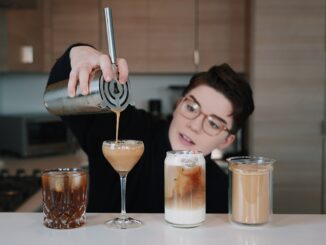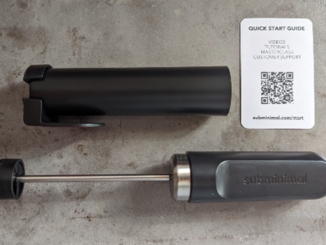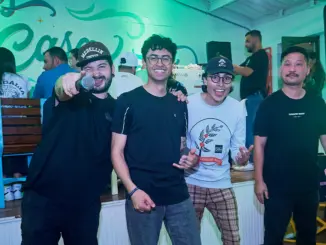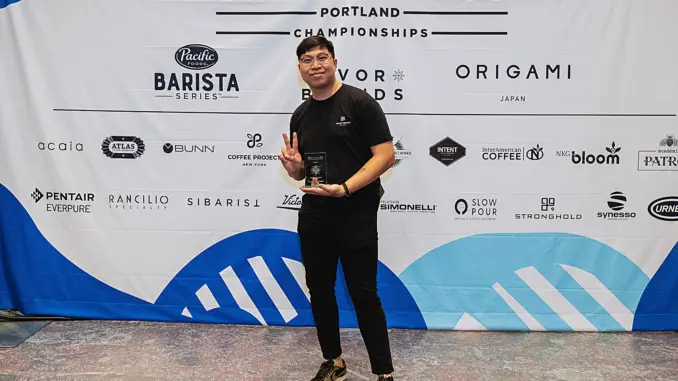
Piyapat Lapteerawut, U.S. Latte Art Champion for the second year in a row, talks about his personal story and the path that will lead him to participate in the WLAC next November in Taiwan.
BY TANYA NANETTI
SENIOR ONLINE CORRESPONDENT
Photos by Matthew Temple
In April 2022, in the first incarnation of the U.S. Latte Art Championship (USLAC), veteran latte artist Piyapat Lapteerawut, who goes by the nickname “Flook,“ took home the top prize. At this year’s U.S. Latte Art Championship in Portland, Ore., in April, Flook once again won the competition; he will travel to Taiwan later this year to take part in the World Latte Art Championship (WLAC). We talked to Flook about latte art, preparing for competition, and much more.
Barista Magazine: Hi Flook, congratulations on your latest victory in the U.S. Latte Art Championship! Can you tell us how it feels to be crowned champion for the second year in a row?
Flook: Of course it feels great; who doesn’t like being a winner? But I felt even better when I saw that new faces came to the competition this year. I noticed more awareness in the latte art community, with new people starting to practice and wanting to participate in the competition, and that made me excited. It’s a great feeling to be an inspiration!
How has your approach to latte art and latte art competitions changed over the past year? What have you learned? How did the first win help you achieve the same result again?
First of all, in the past year, I started to train more, knowing that there are so many talented baristas out there. I had to be more prepared than last year, and there was more pressure because this year the winner will move on to WLAC (unlike last year). Fortunately, my competition experience helps me in the R&R and routine part: knowing what to do and what not to do helps me focus more on my concept and design.
Tell us about the latte art designs that enabled you to become U.S. 2023 champion. What did they represent? How did you come up with the ideas?
I work in education, and I know that learning can be fun or stressful; my teaching style focuses on making sure students have fun and learn at the same time.
This is the path I chose for the latte art championship: I thought I would educate the audience in the same way I do in my classes, but the main question was, “What should I teach?“ So, I chose one of my favorite themes, a bird, and then turned the theme into a story, showing people what the current trend is and how latte art has evolved in recent years.
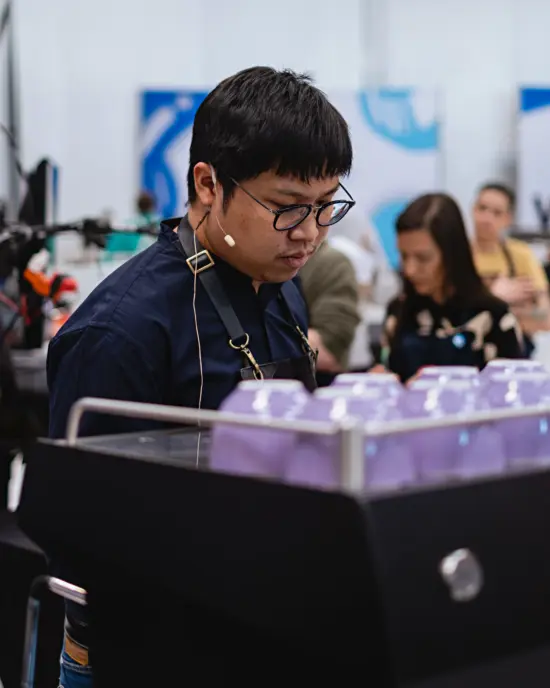
In 2018, Irvine Quek (World Latte Art Champion from Malaysia) created an extremely difficult design, a hornbill bird, which went viral in the latte art community: I wanted to show people what a hornbill looks like without copying Irvine by creating a bird with a different posture that is easier to pour. I wanted the public to learn and see that these designs can be both difficult and easy.
In 2019, Manuela Fensore (World Latte Art Champion from Italy) won by pouring a horse and an eagle face. This opened another possibility to the world of latte art, portrait design, which has suddenly become very popular because it can score well on the scorecard. But surprisingly, portrait design is not yet common in the U.S., and I wanted to show its full potential, so I chose a rooster head that scored well on a scorecard, as I expected.
Finally, for the macchiato, I chose a design to match the theme, adding more technique to the design. My first two drawings referred to past years, but here I wanted to show what is now, and what the future can look like: Latte art can be even more complex, with so many techniques that can be learned.
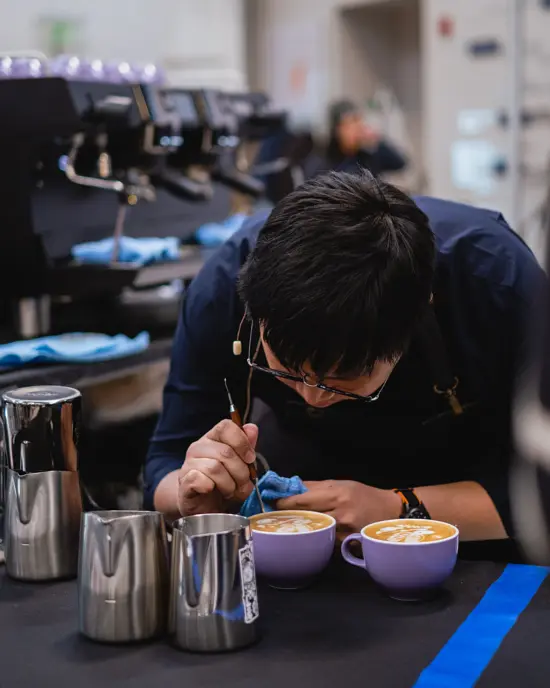
We learned a lot about you when we interviewed you last year, but there are other things we would like to know, starting with the changes in your life when you moved to the United States.
I moved to the U.S. six years ago for my master’s degree career. Before, I was a barista and coffee shop manager in a small coffee shop in Thailand, where at that time the specialty-coffee industry was still developing.
I had been in the U.S. for a few months when, quite by chance, I went to a coffee shop in Washington, D.C., where one of the baristas introduced me to something called a TNT (Thursday Night Latte Art Throwdown). This opened a new door for me.
Of course there were latte art competitions in Thailand, but at that time they were like twice a year, whereas in the U.S. there were already many, every month. All the baristas were there to compete and relax; it was a great atmosphere and I made so many acquaintances with other baristas!
What about your academic career? You studied to become an engineer and then switched to coffee. Did you abandon your studies completely? Or are you still doing something related?
LOL. Yes, but not completely. Actually, people know that I majored in engineering, but not many know that I actually majored in civil engineering and specialized in plumbing. So, most of the time I fixed all the pipes and plumbing in the café (at least I can still use my engineering skills in a café). Sometimes it is also quite useful with the espresso machine: I can identify the source of the leak or any problem with the drain or pipe, and this really helps me communicate with the technician (even if I don’t know how to fix the machine, I can tell where the problem is).
In addition, I have an MBA degree, which is why I joined Coffee Project New York as a wholesale manager, dealing with customers, finding new customers, and sales.
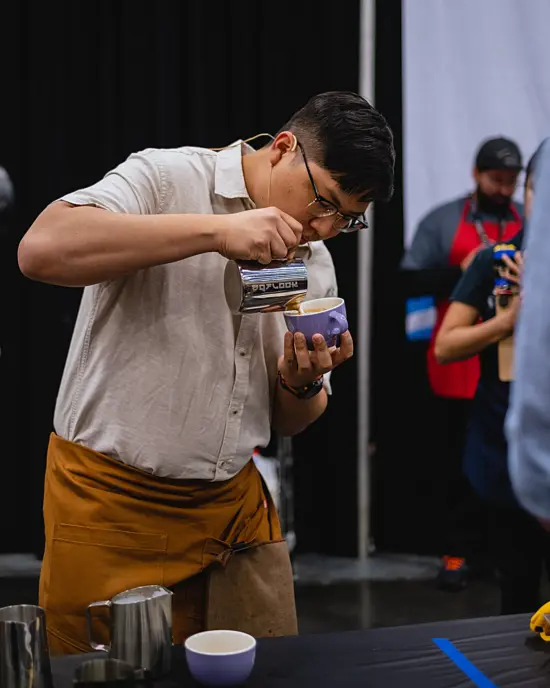
You currently work as wholesale program manager at Coffee Project New York. Can you tell us more about your work?
I am currently a latte art instructor and wholesale program manager at Coffee Project New York. My main role is to teach both the public and customers (and sometimes train our staff). Basically, if you buy coffee from us, my job is to make sure you know how to brew it correctly.
Last year you told Barista Magazine about your project to create a platform or website to help other people interested in competing in latte art competitions by sharing knowledge, helping people avoid basic mistakes, and helping them succeed. How is this project progressing?
OMG! What a shame on me. This project did not go well for so many reasons, mainly money. Building a studio for a production costs a lot of money, and unfortunately, I don’t have the funds to do it. Also, I went back to Thailand for a while to spend time with family and friends, but while I was there I was still working as a barista and practicing latte art, participating in latte art competitions around the country.
That’s how I drastically improved my latte art skills in a short period of time. I would honestly say that during the six months in Thailand, I practiced harder than (during the) two years in the United States.
But now I am back, and at Coffee Project New York we are working on a latte art program where people interested in competing can learn and practice, to try to become the new champion. Stay tuned!
Many latte artists look to you for inspiration: What suggestions do you have for them? What does it take to become so good at latte art that you can aspire to become the next champion in one of the national competitions around the world?
I’d say, “Practice, practice, and practice!“
I look at latte art as a career, training and competing seriously. It’s like practicing a sport or music, which requires muscle memory to master. A long practice can be really tiring both mentally and physically: just take a break and go back to it, never forgetting to have fun. Also, don’t forget why you do latte art: remember the first day you tried and nothing came out, the moment you poured your first heart (compared to what you can do today), the first unicorn. … Always be proud of yourself. You are doing great.
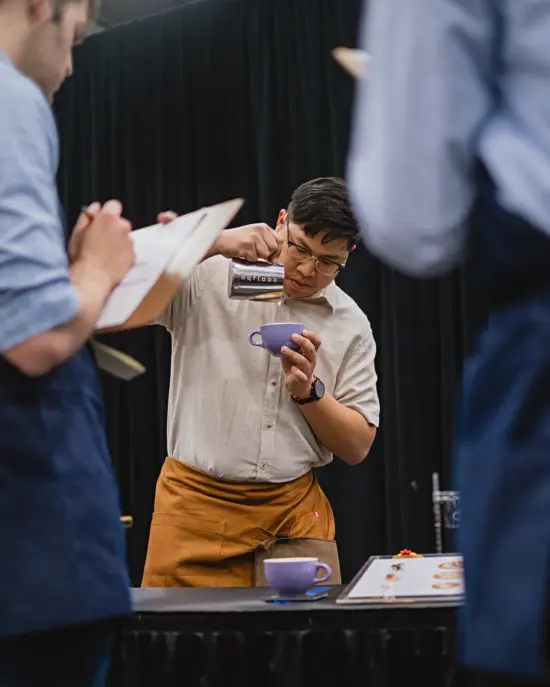
Speaking of competitions again: With this new victory, you will finally have a chance to participate in the World Latte Art Championship, in November in Taipei, Taiwan. What are your thoughts on this? Are you already training?
I’m very nervous, but I’m also feeling very good because I will finally have the chance to get on the world stage (one of my desires since the first competition).
I will start training seriously around July because trends are always changing and I don’t want to train now and then have to change my routine or design later. Right now I am still practicing some common latte art, mastering my rosetta, trying different designs, and learning as many techniques as I can.
Let’s talk about the future. Is there any new project you want to share? New goals? What are your expectations for the near and distant future?
I don’t have any particular plans for the near future, but I would like to share my views on the future of latte art. I think there will be more people competing for the USLAC, new competitors who are experienced and more confident not only in latte art but also in the competition routine and the SCA competition format.
But in the meantime, I also see some good latte artists dropping out because they don’t see the value of it. And I’m not going to lie, it’s true: I see fewer people coming to local competitions now than in recent years, and if this continues, the skill gap between old and new will continue to grow. Also, let’s not forget that latte art competitions can be intimidating.
I think we are all on the same “bus“ called Coffee Community, and we all need to push it, engaging newcomers to compete, get out of their comfort zone, learn something new, and see the true value of latte art.
We all need to be together, creating a big impact in the industry.
ABOUT THE AUTHOR
Tanya Nanetti (she/her) is a specialty-coffee barista, a traveler, and a dreamer. When she’s not behind the coffee machine (or visiting some hidden corner of the world), she’s busy writing for Coffee Insurrection, a website about specialty coffee that she’s creating along with her boyfriend.


